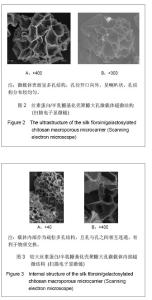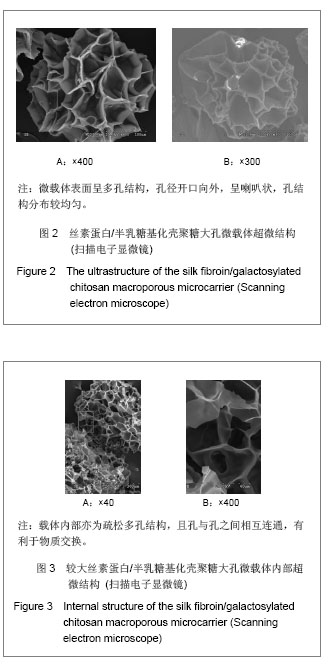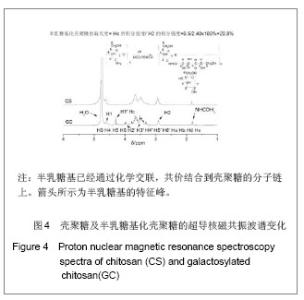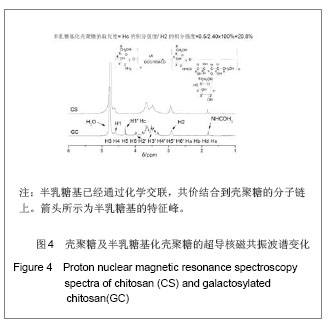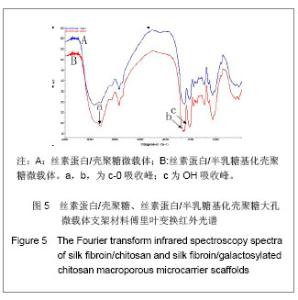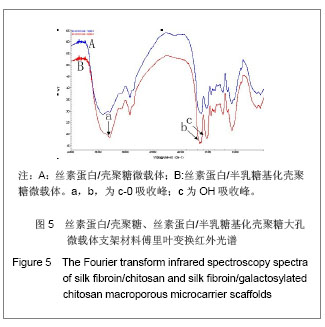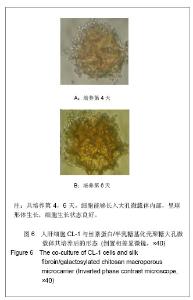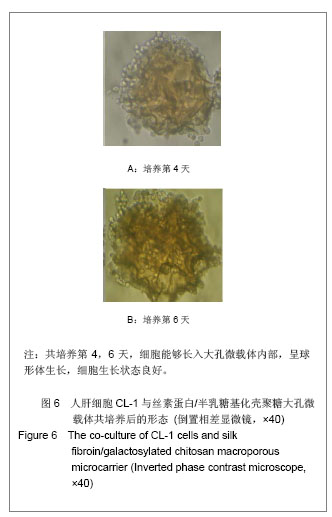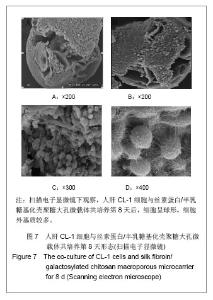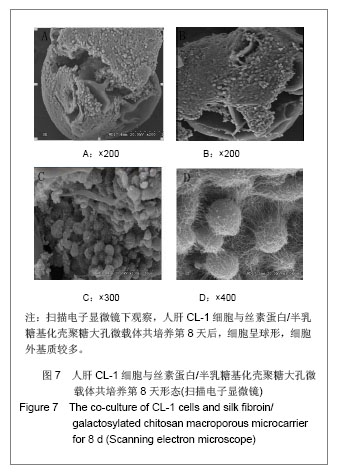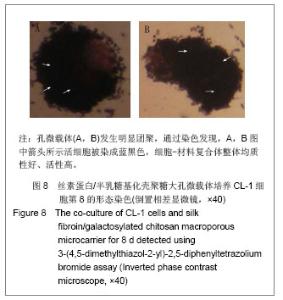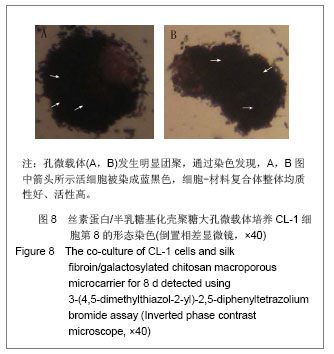Chinese Journal of Tissue Engineering Research ›› 2013, Vol. 17 ›› Issue (16): 2994-3001.doi: 10.3969/j.issn.2095-4344.2013.16.021
Previous Articles Next Articles
Preparation and characterization of hepatocyte-specific macroporous microcarrier
Guo Wei, Gong Du-hui, Hu Zhi-wei, Cheng Yuan, Gao Yi, Pan Ming-xin
- Second Department of Hepatobiliary Surgery, Zhujiang Hospital, Southern Medical University, Guangzhou 510282, Guangdong Province, China
-
Received:2013-03-15Revised:2013-03-19Online:2013-04-16Published:2013-04-16 -
Contact:Pan Ming-xin, Doctor, Chief physician, Professor, Second Department of Hepatobiliary Surgery, Zhujiang Hospital, Southern Medical University, Guangzhou 510282, Guangdong Province, China pmxwxy@sohu.com -
About author:Guo Wei★, Studying for master’s degree, Physician, Second Department of Hepatobiliary Surgery, Zhujiang Hospital, Southern Medical University, Guangzhou 510282, Guangdong Province, China 921329794@qq.com -
Supported by:he National High Technology Research and Development Program of China (863 Program), No. 2006AA02A141*; the Science and Technology Plan of Guangdong Province, No. 2007B010600009*
CLC Number:
Cite this article
Guo Wei, Gong Du-hui, Hu Zhi-wei, Cheng Yuan, Gao Yi, Pan Ming-xin. Preparation and characterization of hepatocyte-specific macroporous microcarrier[J]. Chinese Journal of Tissue Engineering Research, 2013, 17(16): 2994-3001.
share this article
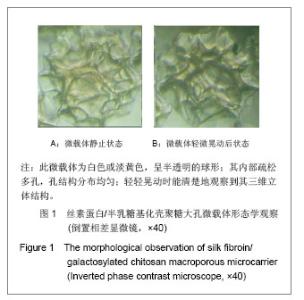
2.1 丝素蛋白/半乳糖基化壳聚糖大孔微载体的吸水率和密度 经冷冻干燥处理得到的丝素蛋白/半乳糖基化壳聚糖大孔微载体,完全保持了其三维网络结构, 这种结构使其容易溶胀,吸水率可达5.4 mL/g以上,随着半乳糖基化壳聚糖所占比例的增加而略有增加。通过此方法制备出的微载体结构疏松,湿态微载体密度较小,经反复多次测量,其浓度为1.02-1.05 g/mL,适合用于旋转微重力培养及搅拌培养。 2.2 丝素蛋白/半乳糖基化壳聚糖大孔微载体的形态 见图1。 图1为倒置显微镜下观察丝素蛋白/半乳糖基化壳聚糖大孔微载体:该大孔微载体为白色或淡黄色,呈半透明的球形;其内部疏松多孔,孔结构分布均匀;轻轻晃动时能清楚地观察到其三维立体结构。该大孔微载体内部疏松多孔的结构扩大了比表面积,并提供了较大的空体积,能将细胞固定在孔内生长,且便于观察,适合用于肝细胞高密度培养。"
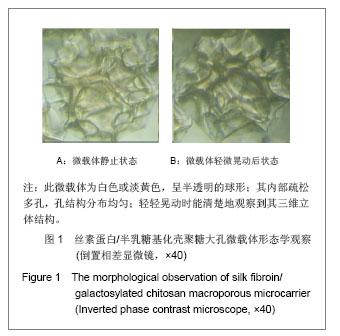
| [1]Hoekstra R, Nibourg GA, van der Hoeven TV, et al. The HepaRG cell line is suitable for bioartificial liver application. Int J Biochem Cell Biol. 2011;43(10):1483-1489.[2]Pan XP, Li LJ. Advances in cell sources of hepatocytes for bioartificial liver. Hepatobiliary Pancreat Dis Int. 2012;11(6): 594-605.[3]Barakat O, Abbasi S, Rodriguez G, et al. Use of Decellularized Porcine Liver for Engineering Humanized Liver Organ. J Surg Res. 2012;173(1):e11-25. [4]Wu C, Pan J, Bao Z, et al. Fabrication and characterization of chitosan microcarrier for hepatocyte culture. J Mater Sci Mater Med. 2007;18(11):2211-2214.[5]Park Y, Subramanian K, Verfaillie CM, et al. Expansion and hepatic differentiation of rat multipotent adult progenitor cells in microcarrier suspension culture. J Biotechnol. 2010;150(1): 131-139. [6]Eibes G, dos Santos F, Andrade PZ, et al. Maximizing the ex vivo expansion of human mesenchymal stem cells using a microcarrier-based stirred culture system. J Biotechnol. 2010; 146(4):194-197.[7]Rustad KC, Wong VW, Sorkin M, et al. Enhancement of mesenchymal stem cell angiogenic capacity and stemness by a biomimetic hydrogel scaffold. Biomaterials. 2012;33(1): 80-90.[8]Bhardwaj N, Nguyen QT, Chen AC, et al. Potential of 3-D tissue constructs engineered from bovine chondrocytes/silk fibroin-chitosan for in vitro cartilage tissue engineering. Biomaterials. 2011;32(25):5773-5781. [9]Rigopoulou EI, Roggenbuck D, Smyk DS, et al. Asialoglycoprotein receptor (ASGPR) as target autoantigen in liver autoimmunity: lost and found. Autoimmun Rev. 2012; 12(2): 260-269.[10]Selman L, Hansen S. Structure and function of collectin liver 1 (CL-L1) and collectin 11 (CL-11, CL-K1). Immunobiology. 2012;217(9):851-863.[11]Wen X, Peng X, Fu H, et al. Preparation and in vitro evaluation of silk fibroin microspheres produced by a novel ultra-fine particle processing system. Int J Pharm. 2011; 416(1):195-201. [12]Zheng D, Duan C, Zhang D, et al. Galactosylated chitosan nanoparticles for hepatocyte-targeted delivery of Oridonin. Int J Pharm. 2012;436(1-2):379-386.[13]Li L, Qian Y, Jiang C, et al. The use of hyaluronan to regulate protein adsorption and cell infiltration in nanofibrous scaffolds. Biomaterials. 2012;33(12):3428-3445. [14]Park IK, Yang J, Jeong HJ, et al. galactosylated chitosan as a synthetic extracellular matrix for hepatocytes attachment. Biomaterials. 2003;24(13):2331-2337.[15]Park TG. Perfusion culture of hepatocytes within galactose derivatized biodegradable poly (lactide-co-glycolide) scaffolds prepared by gas foaming of effervescent salts. J Biomed Mater Res. 2002;59(1):127-135.[16]Jin H J, Chen JS, Karageorgiou V, et al. Human bone marrow stromal cell responses on electrospun silk fibroin mats. Biomaterials. 2004;25(6):1039-1047.[17]Wu XB, Peng CH, Huang F, et al. Preparation and characterization of chitosan porous microcarriers for hepatocyte culture. Hepatobiliary Pancreat Dis Int. 2011; 10(5):509-515.[18]Duan B, Wang M, Zhou WY, et al. Three-dimensional nanocomposite scaffolds fabricated via selective laser sintering for bone tissue engineering. Acta Biomater. 2010; 6(12):4495-505. [19]Barakat O, Abbasi S, Rodriguez G, et al. Use of decellularized porcine liver for engineering humanized liver organ. J Surg Res. 2012;173(1):e11-25. [20]Wei X, Zhang Z, Qian Z, et al. Pharmacokinetics and in vivo fate of drug loaded chitosan nanoparticles. Curr Drug Metab. 2012;13(4):364-371.[21]Bhardwaj N, Kundu SC. Chondrogenic differentiation of rat MSCs on porous scaffolds of silk fibroin/chitosan blends. Biomaterials. 2012;33(10):2848-2857.[22]Wang Y, Bella E, Lee CS, et al. The synergistic effects of 3-D porous silk fibroin matrix scaffold properties and hydrodynamic environment in cartilage tissue regeneration. Biomaterials. 2010;31(17):4672-4681.[23]Wen X, Peng X, Fu H, et al. Preparation and in vitro evaluation of silk fibroin microspheres produced by a novel ultra-fine particle processing system. Int J Pharm. 2011; 16(1):195-201. [24]Lu Q, Huang Y, Li M, et al. Silk fibroin electrogelation mechanisms. Acta Biomater. 2011;7(6):2394-400. [25]Waldert M, Klatte T, Haitel A, et al. Hybrid renal cell carcinomas containing histopathologic features of chromophobe renal cell carcinomas and oncocytomas have excellent oncologic outcomes. Eur Urol. 2010;57(4):661-665. [26]Silva GA, Coutinho OP, Ducheyne P, et al. The efect of starch and starch-bioactive glass composite microparticles on the adhesion and expression of the osteoblastic phenotype of a bone cell line. Biomaterials. 2007;28(2):326-334. [27]Harada K, Mitaka T, Miyamoto S, et al. Rapid formation of hepatic organoid in collagen sponge by rat small hepatocytes and hepatic nonparenchymal cells. J Hepatol. 2003;39(5): 716-723.[28]Chung HJ, Kim IK, Kim TG, et al.Highly open porous biodegradable microcarriers: in vitro cultivation of chondrocytes for injectable delivery. Tissue Eng Part A. 2008;14(5):607-615.[29]Ohashi K, Yokoyama T, Yamato M, et al. Engineering functional two- and three-dimensional liver systems in vivo using hepatic tissue sheets. Nat Med. 2007;13(7):880-885. |
| [1] | Wang Feng, Zhou Liyu, Saijilafu, Qi Shibin, Ma Yanxia, Wei Shanwen. CaMKII-Smad1 promotes axonal regeneration of peripheral nerves [J]. Chinese Journal of Tissue Engineering Research, 2021, 25(7): 1064-1068. |
| [2] | Li Li, Ma Li. Immobilization of lactase on magnetic chitosan microspheres and its effect on enzymatic properties [J]. Chinese Journal of Tissue Engineering Research, 2021, 25(4): 576-581. |
| [3] | Li Xinping, Cui Qiuju, Zeng Shuguang, Ran Gaoying, Zhang Zhaoqiang, Liu Xianwen, Fang Wei, Xu Shuaimei. Effect of modification of β-tricalcium phosphate/chitosan hydrogel on growth and mineralization of dental pulp stem cells [J]. Chinese Journal of Tissue Engineering Research, 2021, 25(22): 3493-3499. |
| [4] | Zhou Anqi, Tang Yufei, Wu Bingfeng, Xiang Lin. Designing of periosteum tissue engineering: combination of generality and individuality [J]. Chinese Journal of Tissue Engineering Research, 2021, 25(22): 3551-3557. |
| [5] | Lang Limin, He Sheng, Jiang Zengyu, Hu Yiyi, Zhang Zhixing, Liang Minqian. Application progress of conductive composite materials in the field of tissue engineering treatment of myocardial infarction [J]. Chinese Journal of Tissue Engineering Research, 2021, 25(22): 3584-3590. |
| [6] | Chen Siyu, Li Yannan, Xie Liying, Liu Siqi, Fan Yurong, Fang Changxing, Zhang Xin, Quan Jiayu, Zuo Lin. Thermosensitive chitosan-collagen composite hydrogel loaded with basic fibroblast growth factor retards ventricular remodeling after myocardial infarction in mice [J]. Chinese Journal of Tissue Engineering Research, 2021, 25(16): 2472-2478. |
| [7] | Liu Feng, Zhang Yu, Wang Yanli, Luo Wei, Han Chaoshan, Li Yangxin. Application of temperature-sensitive chitosan hydrogel encapsulated exosomes in ischemic diseases [J]. Chinese Journal of Tissue Engineering Research, 2021, 25(16): 2479-2487. |
| [8] | Li Jie, Xu Jianzhen, Hu Ping, Lei Qiqi, Zhang Wenning, Ao Ningjian . Preparation and performance evaluation of carboxymethyl chitosan/oxidized glucomannan/Panax notoginseng compound sponge dressing for chronic wound [J]. Chinese Journal of Tissue Engineering Research, 2021, 25(16): 2528-2534. |
| [9] | Chen Zhenyu, Zhang Xiaoning, Luo Yuxin, Liang Jianwei, Yan Chi. Evaluation of silk fibroin/curcumin composite film for promoting wound healing [J]. Chinese Journal of Tissue Engineering Research, 2021, 25(16): 2554-2561. |
| [10] | Xie Jian, Su Jiansheng. Advantages and characteristics of electrospun aligned nanofibers as scaffolds for tissue engineering [J]. Chinese Journal of Tissue Engineering Research, 2021, 25(16): 2575-2581. |
| [11] | Ji Qi, Yu Zhengwen, Zhang Jian. Problems and trends of technique and clinical application of metallic biomaterials prepared by three-dimensional printing technology [J]. Chinese Journal of Tissue Engineering Research, 2021, 25(16): 2597-2604. |
| [12] | Yang Fan, Liu Baoyi, Liu Jiahe, Yang Jiahui, Qin Kairong, Zhao Dewei. Morphological characteristics of in vitro cultured articular chondrocytes from Sprague-Dawley rats at passage number from 0 to 3 [J]. Chinese Journal of Tissue Engineering Research, 2021, 25(14): 2161-2165. |
| [13] | Qian Nannan, Zhang Qian, Yang Rui, Ao Jun, Zhang Tao. Mesenchymal stem cells in the treatment of spinal cord injury: cell therapy and combination of new drugs and biomaterials [J]. Chinese Journal of Tissue Engineering Research, 2021, 25(13): 2114-2120. |
| [14] | Yan Nan, Si Xiaofeng, Zeng Liang, Tian Wei, Shan Guangdong, Xiong Lishuo, Yang Weijie, Wang Zhengdong. Nerve growth factor interferes with proliferation and alpha-actin expression of skeletal muscle satellite cells in rats [J]. Chinese Journal of Tissue Engineering Research, 2021, 25(13): 2030-2035. |
| [15] | Jia Wei, Zhang Mandong, Chen Weiyi, Wang Chenyan, Guo Yuan. Effects of femoral prosthetic materials on artificial knee arthroplasty performance [J]. Chinese Journal of Tissue Engineering Research, 2021, 25(10): 1477-1481. |
| Viewed | ||||||
|
Full text |
|
|||||
|
Abstract |
|
|||||
